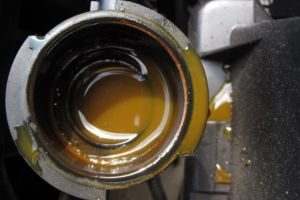Professional disposal of oil-contaminated coolant
Need to dispose of oil-contaminated coolant? Use our Business Pickup Service. Contact us or request a free, no-obligation quote.
Oil in coolant is more common than you think and is usually caused by a leak or defect in the engine or cooling system. When oil mixes with coolant, the mixture loses its effectiveness, can cause serious engine damage, and creates an environmentally hazardous chemical waste product. Therefore, oil-contaminated coolant must be disposed of properly. Coolant disposal always needs to be done professionally by a certified processor.
This article explains how oil forms in coolant, what the risks and consequences are, and how to dispose of this fluid safely.

Oil in coolant usually occurs due to a defect or leak in the engine or cooling system. The oil and coolant then enter each other's circuit, forming a contaminated mixture that is no longer usable. Possible causes include:
You can recognize coolant containing oil by its brown or milky color and a greasy film on the surface or in the expansion tank. Sometimes you'll see traces of oil in the radiator or under the coolant reservoir cap. This almost always indicates a mixture of oil and coolant.
Oil in a coolant reservoir causes more than just reduced cooling efficiency. It can have the following consequences:
In addition, the liquid is classified as hazardous waste, which makes disposal mandatory under environmental legislation.
Cleaning oil in coolant is no easy task. Because oil and coolant are highly intermixed, simply emptying or refilling the expansion tank isn't enough. The entire cooling system must be flushed with a specialized cleaning agent to remove all oil and sludge residue.
After flushing, the system is filled with new, clean coolant. The old, contaminated coolant contains harmful substances and must be disposed of as chemical waste.
Once oil enters coolant, this mixture is considered chemical waste (coolant and used oil are also classified separately as chemical waste). It may not be discharged, incinerated, or mixed with other residual or commercial waste. It may also not be disposed of down the drain or sewer, as it can cause serious harm to humans, animals, and the environment.
Processing falls under the Environmental Management Act and the Activities Decree. Only certified collectors are permitted to transport and process this waste. They are supervised and must comply with chemical waste legislation at all times.
Companies can dispose of oil-contaminated coolant through a certified collection agency such as Chemisch Afval Nederland (Chemical Waste Netherlands). We ensure safe collection, approved storage containers, transport, and processing through certified processing facilities.
The costs for oil-based coolant and drain glycol depend on various factors, such as the degree of contamination, the quantity, and the type of packaging. Chemical Waste Netherlands always offers a competitive rate and a clear quote upfront.
Simply request a no-obligation quote to get a concrete idea of the rates.
Oil in coolant means that oil and coolant have mixed due to a leak or defect. This makes the coolant unusable and harmful to the environment.
Yes, oil in coolant is considered chemical waste. It may not be disposed of with residual waste or in the sewer system.
If there's oil in your coolant, it means there's an internal leak or damage to the engine or cooling system. It's a sign that oil and coolant are mixing, which can lead to overheating, corrosion, and high repair costs. The coolant is also hazardous waste and must be disposed of professionally.
You can't manually remove oil from an engine's coolant because the mixture of oil, water, and glycol is difficult to separate. The cooling system must first be completely cleaned or flushed by a mechanic to prevent further damage. The contaminated coolant is then considered chemical waste and must be disposed of by a certified waste collector.
You can recognise oil in coolant by a milky or brown haze, a greasy layer on the coolant reservoir or an oily layer on the water surface.
After collection, the fluid is treated in specialized facilities. Oil and water are separated, glycol is purified and reused, and harmful substances are safely removed.
Yes, oil can get into the coolant due to a leak or defect in the engine or cooling system. This is often caused by a leaking cylinder head gasket, a cracked oil cooler, or a crack in the cylinder head. The oil then mixes with the coolant, contaminating the system and reducing its cooling capacity.
No, you should not continue driving with oil in the coolant. The mixture loses its cooling capacity, causing the engine to quickly overheat and cause serious damage. Have the car checked by a mechanic immediately and have the contaminated coolant professionally disposed of by a certified treatment facility.
Need to dispose of oil-contaminated coolant? Use our Business Pickup Service. Contact us or request a free, no-obligation quote.
